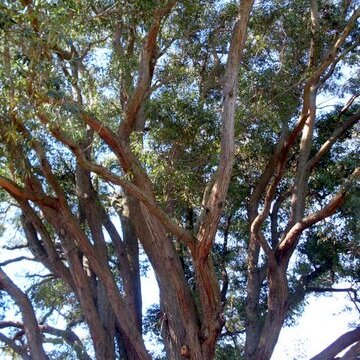Medium-sized or tall tree to 45 m high (to 25 m in dry sites, elsewhere to 60 m high, fide Chippendale 1988: 140). Forming a lignotuber.Bark rough to small branches, fibrous, grey or grey-brown, held in flattish strips rather than typical stringybark.Juvenile growth (coppice or field seedlings to 50 cm): stem rounded in cross-section, smooth; juvenile leaves opposite and sessile for many pairs before becoming alternate and shortly petiolate, usually lanceolate, rarely ovate, 5–12.5 cm long, 1.3–5.7 cm wide, base usually rounded, rarely stem-clasping, discolorous, glossy, green.Leaves become alternate at about knee-high.Adult leaves alternate; petiole 0.7–2.1 cm long; blade lanceolate, (6.2) 7–15.7 cm long, 0.9–4 (5) cm wide, base oblique or tapering to petiole, margin entire, discolorous, weakly glossy to quite glossy, green, side-veins about or greater than 45° to midrib, moderately to densely reticulate, intramarginal vein parallel to and just within margin or well removed from it, oil glands island and intersectional.Inflorescence terminal, or axillary unbranched, peduncles 0.7–1.9 cm long, buds 11 to 15 per umbel, rarely more, pedicels 0.3–0.7 cm long.Mature buds ovoid to fusiform, 0.5–0.7 cm long, 0.3–0.5 cm wide, green to yellow, scar absent, operculum conical or sometimes beaked, stamens irregularly flexed or inflexed, anthers reniform to cordate, versatile, dorsifixed, dehiscing by confluent slits, style long, locules 3–5 each with two vertical ovule rows.Flowers white.Fruit pedicellate (pedicels 0.1–0.8 cm long), truncate-globose to hemispherical or cup-shaped or sometimes urn-shaped, 0.5–0.8 cm long, 0.4–0.9 cm wide, disc below rim level, usually descending and concealed but sometimes visible and oblique, valves 3–5, rim level or below.Seeds brown, 1–2.5 mm long, pyramidal or obliquely pyramidal, dorsal surface smooth, hilum terminal.


